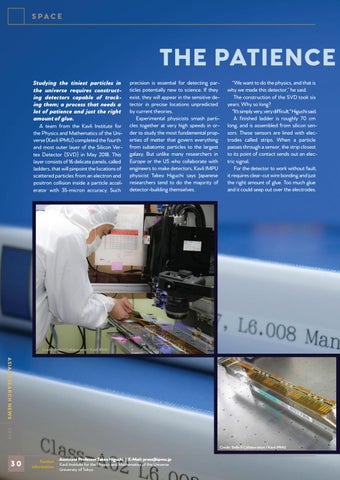S PAC E
THE PATIENCE Studying the tiniest particles in the universe requires constructing detectors capable of tracking them; a process that needs a lot of patience and just the right amount of glue.
A team from the Kavli Institute for the Physics and Mathematics of the Universe (Kavli IPMU) completed the fourth and most outer layer of the Silicon Vertex Detector (SVD) in May 2018. This layer consists of 16 delicate panels, called ladders, that will pinpoint the locations of scattered particles from an electron and positron collision inside a particle accelerator with 35-micron accuracy. Such
precision is essential for detecting particles potentially new to science. If they exist, they will appear in the sensitive detector in precise locations unpredicted by current theories. Experimental physicists smash particles together at very high speeds in order to study the most fundamental properties of matter that govern everything from subatomic particles to the largest galaxy. But unlike many researchers in Europe or the US who collaborate with engineers to make detectors, Kavli IMPU physicist Takeo Higuchi says Japanese researchers tend to do the majority of detector-building themselves.
“We want to do the physics, and that is why we made this detector,� he said. The construction of the SVD took six years. Why so long? "It's simply very, very difficult," Higuchi said. A finished ladder is roughly 70 cm long, and is assembled from silicon sensors. These sensors are lined with electrodes called strips. When a particle passes through a sensor, the strip closest to its point of contact sends out an electric signal. For the detector to work without fault, it requires clear-cut wire bonding and just the right amount of glue. Too much glue and it could seep out over the electrodes.
Credit: Belle II Collaboration / Kavli IPMU
ASIA RE SEA RC H N EWS 201 9 Credit: Belle II Collaboration / Kavli IPMU
30
Further information
Associate Professor Takeo Higuchi | E-Mail: press@ipmu.jp Kavli Institute for the Physics and Mathematics of the Universe University of Tokyo
